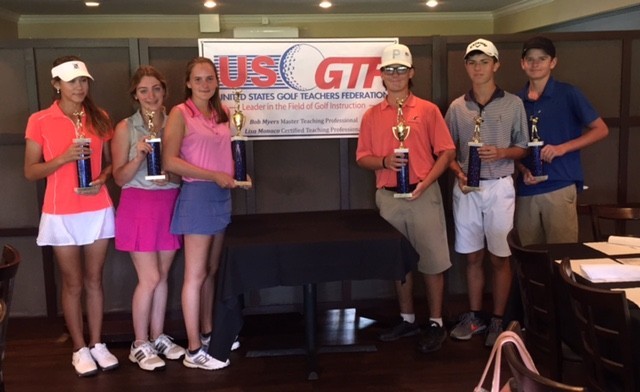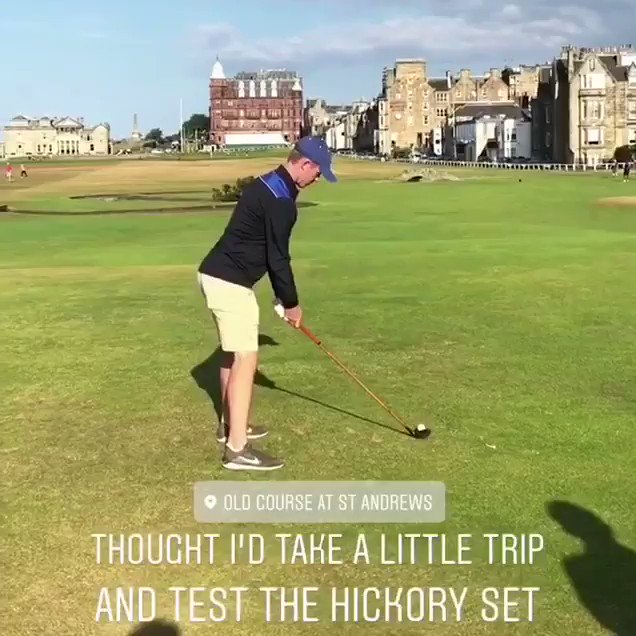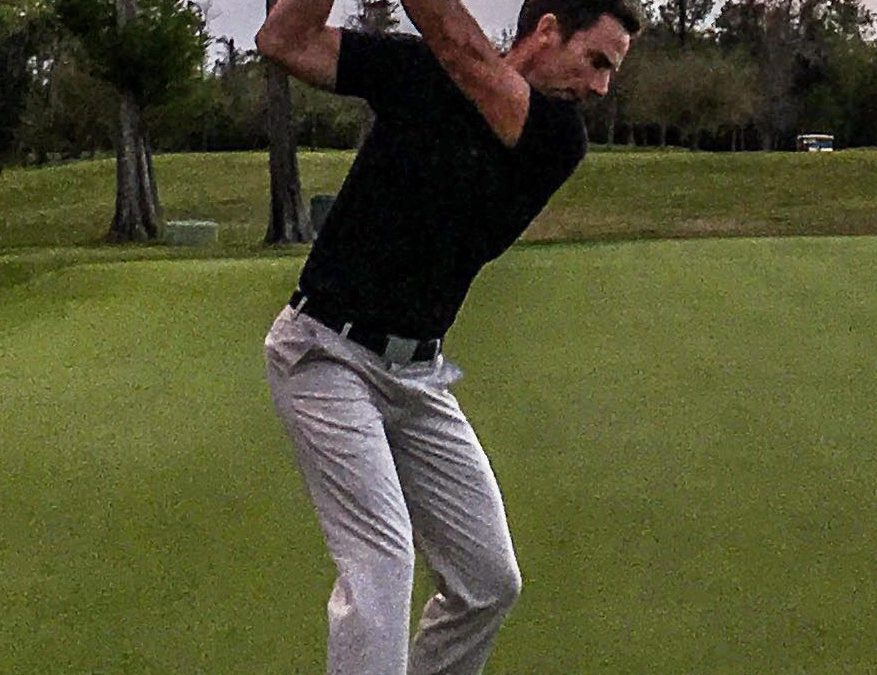Blog
Tour Players Reed and Stone Discover a New Golf Passion
Is Distance Really A Problem?
So, the USGA and the R&A have decided to study all aspects concerning the effect of golf ball distance in golf. It includes amateur and professional golfers worldwide, golf course owners and operators, golf equipment manufacturers, golf course architects and golf course superintendents.
It wasn’t that long ago that they concluded that distance was not an issue. I wonder what changed. I have no idea how much they are going to spend on this research, but in the end, I’ll bet it comes down to something simple. In fact, I can save them a lot of time and effort. The only issues concerning distance is the added cost of maintenance due to lengthening and toughening up golf courses, plus the hour or so longer it takes to play them. Think about it. Fifty years ago, I paid an average of $20 to play the local municipal courses I grew up around. Today in Florida, I pay an average of about $30. Yet, maintenance costs have significantly increased over those same years,
Other than maintenance costs, distance has been extremely lucrative for the other aspects of the game. The professional tours are doing very well. People love the long ball. Average players all want more. As the Geico commercials say, there’s a lot to be said about more. Manufacturers get top dollar for clubs and balls that go farther. Is pulling back really what people are going to want? Doubtful! Here is my bottom line: Roll back the playing surface to a reasonable length and make them easier to maintain. Distance just changes strategy. Instead of laying up, the new norm will be going for it. So what if I can drive a par-four? It is always about who shoots the lowest score. Does it really matter how it is done? The quest for distance has been a staple of golf since its origin. Why stop now?
Frequency Of Lessons
 By Cole Golden, USGTF Member, Wichita, Kansas
By Cole Golden, USGTF Member, Wichita, Kansas
I was recently asked by a student how often he should take a lesson. I usually let the student take the lead on this type of conversation to get a feel for where their head is at, and how serious they are about improving their game. I carefully considered the student’s question to provide him with the best possible answer. While I would love for a student to take a lesson every week so that I could carefully watch and help them, is that what is right for the student?
I told this particular student that I would like him to practice at least twice between lessons. There is a “method to my madness.” It gives a student time to work on the recommended adjustments and comprehend any positives or negatives from the previous lesson. Maybe we are working on containing a good spine angle, and after a couple of practice rounds they feel like they can’t get through the ball.
Or maybe we have been working on a certain shot shape and they get it down, ready to move onto the next.
Giving a student a chance to work on drills outside of a paid lesson is a more efficient and effective use of your time and theirs. If a student doesn’t practice, it doesn’t matter how many lessons they take. While you want to help them along, they must have time to work on things prior to moving on to the next lesson. Some instructors offer ten-minute lessons that are good for students who don’t practice a lot. This is a “quick look” type of lesson and it serves a purpose.
Having a well-thought out, personalized game plan with your students shows them that you care about their progress as a player. It also helps you manage your schedule more efficiently.
Everyone’s Obsessed About Distance, Distance, Distance
 Turn on Golf Channel or access virtually any golf media source, and one of the main topics of 2018 is “how far the ball is going,” or in other words, how far tour pros are hitting the ball these days. After years of saying there was no problem, the USGA and R&A are now claiming that something has to be done.
Turn on Golf Channel or access virtually any golf media source, and one of the main topics of 2018 is “how far the ball is going,” or in other words, how far tour pros are hitting the ball these days. After years of saying there was no problem, the USGA and R&A are now claiming that something has to be done.
Jack Nicklaus has long advocated for rolling the ball back, and he was saying this 25 years ago when balata balls were still in use and the median driving distance for tour pros was 260.5 yards. For the most recent completed golf season, 2016-2017, that number is now 292.5. Based on 14 tee shots per round, that means tour venues today effectively play 448 yards shorter as compared to 1993. To keep up, that 6,900-yard course in 1993 must be stretched out to 7,348 yards to have equivalent approach yardages.
The gatekeepers of the game and media pundits say that golf architects today are “forced” to design such behemoth courses in order to “keep up with the ball.” That only makes sense if such courses are planning to host world-class competitions. Otherwise, there is really very little necessity in doing so. The average golfer hits the ball nowhere near 250 yards off the tee, the minimum distance a scratch golfer is expected to hit the ball, according to the USGA. Most courses have scratch golfers, not tour pros, as their best players, and you would be hard put to find scratch golfers who hit the ball much farther than 275 yards. A 6,900-yard course is more than adequate to test these golfers from a distance point of view.
What’s really behind this focus on how far tour pros hit the ball? Augusta National chairman Fred Ridley said during his annual news conference at the Masters that the par-5 13th hole was designed by Bobby Jones so that going for the green in two was a “monumental decision.” Ridley pointed out that today’s players routinely have a middle or short iron into the green, and that the decision on the second shot is no longer “monumental.” He expressed confidence that “something will be done.”
Unbelievably, it could actually be inferred that all of the talk about how far the ball goes comes down to how the 13th and 15th (another par-5) holes at Augusta National are played by the pros! Think about it – those who run Augusta National are powerful figures who have the ear of the USGA and R&A, and yes, they are listening.
First, most players do not “routinely” hit middle or short irons into that hole. That is reserved for the longest hitters in the game, but right now, many of them are the top players, so naturally they are getting the most attention. If the average driving distance is about 294 yards today, that still leaves a 216-yard approach shot to the 13th hole, which is 510 yards. For most touring professionals, that is not a middle iron, but probably a 4-iron or even a 3-iron, contrary to what you may have been led to believe. And with today’s club lofts being stronger than in years past, that 4-iron and 3-iron are actually closer to the 2-and 1-irons the older fellows hit back in the day.
What are the options that the USGA and R&A have? Here are three of the possibilities:
Enact a local rule allowing for a tournament ball. This would ostensibly solve the “problem” of the ball going too far for touring professionals and at the same time allowing amateurs to enjoy the game. But this presents a myriad of other problems. Elite amateurs who qualify for professional events would have to either learn to play a new ball, or be playing it already but sacrificing his game to those who are not using the shorter ball. Players entering qualifiers for USGA national championships would have to adjust in some manner, too. The handicap system would be in chaos, because someone could use a shorter ball to establish a handicap and then use the longer ball in amateur competitions such as the city or club championship.
Chances of this happening: Minimal.
Roll the ball back for everyone. This would involve making the ball fly shorter than it currently does. Many ranges have limited-flight balls, and the high-quality ones do not feature a ball flight that is markedly any different, other than they go shorter. You can still work the ball left and right, high and low with such balls. Critics say that this will reduce the popularity of the game, for who wants to hit a 5-iron into the green where previously they hit an 8-iron? But it likely presents fewer problems than bifurcating the rules, as a local rule would do.
Chances of this happening: Possible.
Do nothing. Many who favor doing nothing say that the way to reign in tour professionals is to narrow the fairways, grow the rough and firm up the greens, all to prevent the pros from shooting low numbers. But they are missing the point. The pooh-bahs of the game are not concerned with the actual scores the pros are shooting; they are concerned with how the game is being played at that level, and Chairman Ridley’s statement is proof. They don’t want to see pros hit middle and short irons into long par-4s, nor do they want some pros to be able to hit 550-yard par-5s in two shots. That’s the crux of the problem for them, not the scores. They see the “integrity” of courses being challenged. But par is based on what the shortest-hitting scratch golfers can do, not what tour professionals can do. And if a hole’s original “integrity” is lost, a new challenge can take its place. For example, if we go back to the 13th hole at Augusta National, one pro made the insightful comment that the new challenge is now the tee shot and negotiating the bend of the fairway, where in the past no one had any strategic decision to make. They just hit it to the middle of the dogleg with driver, because that’s all they could do.
Chances of this happening: Probable.
The “Great Distance Debate” of 2018 will undoubtedly last for a while until a final decision is issued by the governing bodies. Until then, people will continue to play golf, and given the overall health of today’s game, wonder what exactly the problem is.
How to Get More Distance In the Golf Swing
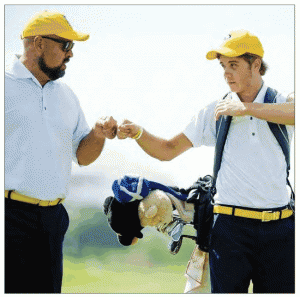 By Arlen Bento Jr. USGTF Member, Jensen Beach, Florida
By Arlen Bento Jr. USGTF Member, Jensen Beach, Florida
If you play golf and love the game, at some point you will notice a loss in distance. Usually, this is due to age, just getting older, losing flexibility and strength.
Over years, many golfers just don’t realize how much distance they have been losing, because over time, they have been making adjustments to their equipment, changing shafts, finding better club technologies and switching golf ball designs. Ultimately, the loss of distance reaches a point where the golfer gets discouraged and starts to seek answers.
For over 20 years I have been helping people with their golf games, and the number one reason people come to see me is that they want more distance. Here is a plan that can help any player that is looking for more distance:
TIP: Learn to use your hips and legs properly in your golf swing to create more speed and distance.
Get your swing analyzed with computer video and fix your flaws. Sometimes, players just have bad technique and are giving away distance. Alot of recreational players that don’t have good golf fundamentals will notice a larger drop in their distance as they get older, because they have learned to use non-fundamental power sources to create speed. Look at older players like Tom Watson, who still generates lots of club speed even at age 68 and is still competitive on the Tour. Watson obviously has a good golf swing, but he swings with tempo, using his legs and hips as well as his arms to create speed. Most recreational players never learned to use their hips and legs properly in the golf swing, and this flaw becomes very noticeable with age.
TIP: Get your club speed, ball speed and launch data analyzed on a launch monitor regularly to make sure your clubs are correct for your speed.
One of the best things you can do as a golfer is to get your club speed, ball speed and launch data analyzed at least once a year if you play golf on a regular basis. Ultimately, it all comes down to physics, and if you don’t have the correct equipment, you are at a huge disadvantage as it relates to distance. Based on how fast you swing, the ball speed you create and how you launch the ball, you need equipment that matches your abilities to get more distance.
TIP: Start a golf fitness and stretching program.
Start a golf-specific fitness and stretching pro-gram to help your body swing faster. Your body is an incredible thing. You will be surprised how just a little effort in working on your body will have amazing results in your golf swing and the ability to generate more distance. Many people don’t understand that your legs have a critical role in the golf swing, much like jumping. When you jump, you use the big muscles of your legs, your core and parts of your body that need to be strong and flexible. I have a great little drill that I offer to clients that anyone can do. Just sit in a sturdy chair, cross your arms across your chest. Using your core and your legs, just stand up, sit back down and repeat8-10 times. Try to sit down slowly to keep your legs engaged. This exercise really helps use your legs and core, which will help your golf swing. If you have medical conditions, please speak with your doctor first before starting any fitness program.
If you are one of the millions of golfers that are struggling with losing distance, make sure to get your swing analyzed, have your equipment checked and start a simple golf fitness program.
You will be on your way to more distance in no time.
Arlen Bento Jr. is an award-winning golf coach, “Top100” world-recognized golf instructor and club fitting expert living in Jensen Beach, Florida. He operates his own indoor golf academy in Stuart and is the co-host of Golf Talk Radio on WSTU 1450 AM. You can listen to his radio show on Wednesday evenings from 6-7 p.m., or watch online at www.golftalkflorida.com. Bento can be reached for instruction at (772) 485-8030, by email at arlenbentojr@gmail.com, or on his website www.arlenbentojrgolflessons.com.
A Look At Old Vs. New Technology
 By Mark Harman, USGTF Course Director, Ridgeland, South Carolina
By Mark Harman, USGTF Course Director, Ridgeland, South Carolina
“Distance is ruining the game!” cry the purists.“All it is on tour is driver/wedge, driver/wedge every hole! Why, back in the day, pros were actually hitting long irons into par-4s!”
It’s helpful if we compare “back in the day” with the modern game in terms of driving distance. The PGA Tour began compiling various statistics in 1980, one of them being driving distance. Comparing the first three years of 1980-82 – when almost everyone used a persimmon driver and a balata ball – to the most recent three years (2015-17), we see that the median driving distance increased from 258 yards to 291, a gain of 33 yards. Some of that is due to the golf ball, some due to the driver, and some due to the stronger athletes now playing the pro game.
I decided to test the one aspect of this that I could, the golf club. At my disposal were my current driver, a 45-inch 10.5° Callaway Big Bertha Alpha 815, a 44-inch 9° Callaway Big Bertha Warbird from the early 1990s, and a 43-inch Wilson 4300 persimmon driver, given to me courtesy of USGTF examiner and good friend Mike Levine. Both Callaways have graphite shafts, while the Wilson has the original steel shaft that came with it. All clubs are standard length for their time, except for my current driver, which I cut down ½”.
Over the course of two different sessions on two different days, I hit 12 shots with each driver each session, resulting in 24 shots with each driver. I used a Callaway Chrome Soft ball, and for measurement purposes, an indoor simulator using the GC Quad from Foresight Sports.
I eliminated the shortest 12 shots for each driver, to better measure the solid strikes as my goal was to measure the technology differences in regard to distance. I suppose using the overall averages could give a window into the forgiveness factor for each driver, but that’s another discussion.
A quick note for those of you familiar with Trackman numbers: The “smash factor” (ball speed divided by the clubhead speed) is lower than what is obtained with TrackMan. Why this is, I’m not exactly sure, but in doing some research and some comparisons, it appears TrackMan measures clubhead speed a little lower and ball speed a little higher than GC Quad.
The distance results are what you would expect: The modern titanium driver is longer than the 1990s-era steel driver, which is longer than the1980s-era persimmon driver. The distance results, at least in this simulation, are linear. In terms of clubhead speed, the longer modern driver is the fastest, while the shorter and heavier persimmon wood is the slowest – again, what you would expect.
What I didn’t necessarily expect was the smash factor for the Wilson persimmon driver was higher than the Warbird’s, and almost on a par with the Alpha 815’s. (For the record, I have tested my driver against the newer 2018 models and find no differences in terms of ball speed, spin rate and carry distance.) I remember reading advertisements and articles from the late 1980s and early 1990s claiming persimmon drivers went farther than the then-newsteel drivers, and this gives credence to that claim.
When we further examine the data, we can see that launch angle and backspin play a significant role in distance, as well as the obvious ball speed number. This is why the Warbird, with higher launch and lower backspin, provides more distance than the Wilson. Had I been able to launch the Wilson higher (which was tough given its low loft), I might have been able to match the Warbird’s distance.
Another unexpected development was the backspin rates of the older models. The Warbird had by far the lowest number, while the Wilson and Alpha 815 were virtually identical. As for the Warbird, a club that I used for six years, the original RCH 90 stock shaft splintered from so much use, and in its place is a ProForce XL, a turn-of-the-century shaft featuring a very stiff tip, so that may have had something to do with the low backspin rate.
Because of USGA limits on driver and ball technology, it’s highly unlikely, if not impossible from a physics standpoint, for equipment to provide any more distance gains in the future. Predictions of “everyone” at the tour level being able to hit the ball 400 yards, or even 350, appear to be greatly exaggerated. While long-drive competitors can attain those distances, they do so by making an extremely aggressive swing that is simply not built for competitive golf, rendering them too inaccurate. I suppose one day someone may be able to figure out a way to keep their 350-yard drives in play often enough to compete, but I doubt it. Currently, former long-drive champ Jamie Sadlowski is making a go of it in the professional competitive ranks, but so far he has yet to achieve any notable success. Dennis Paulson, winner of the 1985 long drive championship, did make it to the PGA Tour and in fact won an event in 2000, but he dialed back his distance significantly in order to do so.
In conclusion, I don’t believe the sky is falling in terms of excessive distance ruining the professional game. Instead, let’s marvel at these players’ skill and ability, and keep in mind that the element of human competition is the most important factor in making golf as compelling as it is at the highest level.

Spine Angle at Impact – The Forgotten Fundamental to Good Shots
When loss of spine angle at impact occurs with better players, often there is a compensation to save the shot. This could be saving the impact with excess hand action or another compensation such as curving the spine. The good player can get away with this fault for some shots, but the fault will eventually lead to stray shots. The most common result in better players is a swing path that is excessively inside to out. This leads to shots that are often well right or left of the target, pending how the clubface matches up with the path at impact.
You will hear better players and instructors calling this fault as being “stuck” on the backswing. I have seen this fault occur in some famous tour professionals. The result is a shot (by a right-handed player) that goes well right. If the hand action is excessive, there is a hard hook shot left. Remember from some of my past instructional articles my saying: “The clubface sends it; the swing path bends it”?
Which leads to the bigger challenge, how do we fix this flaw? A good place to start is actually the golfer’s physical capabilities. When a golfer has a tight lower back or hamstring, or hip issues, this leads to compensations, frequently resulting in loss of the spine angle at impact. It can also just be a poor habit or a sensation of getting more power by thrusting the torso towards the ball. The better sensation is a feeling of squatting into the lead leg on the downswing. The torso should have a slight shift toward the target and then rotate with a feeling that the lead hip and glute are pulling or rotating away from the ball. This is very similar to a squat movement into the lead glute. As the impact position is approached, the spine angle is maintained with a feeling of the lead hip rotating and pushing back into a “wall.” The lead leg will somewhat straighten naturally at impact as the lead hip begins to rise higher than the trailing hip. In this position, the golfer is maximizing the “ground forces” and creating maximum torque and energy (think Rory McIlroy or Justin Thomas).
Losing the spine angle at impact can be a challenging fault to overcome. As this occurs during the dynamic swinging action, drills to cure this fault can be difficult to describe in words. It is best to demonstrate or feel the proper sensation of proper spine angle at impact. For more drills and information, please visit the USGTF Facebook page or my YouTube Channel, where I demonstrate several exercises to help fix this problem.
Ground Forces and Bobby Jones
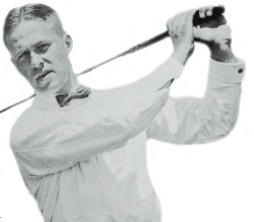
Robert Tyre “Bobby” Jones Jr., circa 1921, Heritage Auctions
By Thomas T Wartelle, USGTF Member, Washington, Louisiana
Robert Tyre Jones, Jr., or “Bobby Jones,” was one of the greatest competitive golfers of all times. He won 13 majors (4 U.S. Opens, 3 Opens, 5 U.S. Amateurs and 1 Amateur). He was also a very learned man with a degree in mechanical engineering and a practicing lawyer.
Bobby Jones was fond of saying that those who are golf instructors are continuously searching for a new way to say the same thing. I could not agree more! In today’s day and age, we have modern technology to analyze and dissect every movement of the golf swing. I certainly am fond of technology and biomechanical study of athletic movement. However, it amuses me to hear of all the “new” breakthroughs of modern teaching. One such example is the phrase “ground forces.” Today, there are advanced analytical tools such as force plates that can measure the transfer of pressure throughout the golf swing.
Humans have been playing golf hundreds of years. There is nothing new to athletic motion, swinging a stick, and hitting an object. The great baseball player Ted Williams wrote one of the finest instructional books on hitting a baseball nearly 50 years ago. This was long before specialized equipment to analyze motion. Likewise, many decades ago Bobby Jones, among others, spoke about the importance of ground forces to powerfully strike a golf ball. Today, many fine players are examples of using ground forces, which in essence means ample use of the torso, hips and legs while maintaining a stable head or spine. One such Tour player is Justin Thomas, who creates tremendous clubhead speed for a smaller-stature athlete. Like many other Tour players, Bubba Watson is also a fine example of someone who maximizes these forces.
Bobby Jones knew and spoke about ground forces in the 1930s. The same can be said of Ben Hogan, who obviously understood the relationship of the clubface at impact to true ball flight laws and the “modern” D-plane theories. As teachers, we must learn to embrace modern technology; however, we must respect and give a nod to the past, as there really is nothing new to striking a golf ball. As Bobby Jones said, “Those of us who strive to explain the golf swing are continually searching for new ways of saying the same thing in the hope that some new slant will appeal to those who have missed the older explanations.”
As golf instructors, we must continue to learn, acknowledge the past, and push on to the future. This will lead to more growth as a golf instructor.
Taking It From the RangeTo the Course
 “I can’t hit the ball on the course as well as I can on the range…I’ve won several U.S. Opens on the range…I’m a scratch golfer on the range but a 15 on the course…” These comments have been made by innumerable golfers over the years.
“I can’t hit the ball on the course as well as I can on the range…I’ve won several U.S. Opens on the range…I’m a scratch golfer on the range but a 15 on the course…” These comments have been made by innumerable golfers over the years.
It’s one of the great mysteries of the game: How can someone hit the ball so well on the practice tee and yet so poorly on the course? Why do people lack the consistency on the course that they have on the range? Fortunately, there are solutions to help our students with this most perplexing of problems.
We must consider that the game as played on the course is completely different than what is happening on the range. On the course, we hit one shot every few minutes, and we’re using a different club each time (except for putting). A normal driving range session consists of using the same club for several consecutive shots, with little or no break between shots.
On the range, most people are using what is called a massed and blocked schedule. Massed means taking virtually no time between repetitions, and blocked means doing the same thing over and over. On the course, that schedule changes to distributed and random. Distributed means taking time between repetitions, and random means that something about the activity changes from repetition to repetition – different distance, direction, club, etc. So right off the bat, people just aren’t practicing the same way that they play the game, not to mention they aren’t practicing on the same venue. In other sports such as baseball and basketball, practice sessions take place on the actual playing surface, but in golf we practice on a practice green and a tee box.
Nevertheless, there are strategies to make practice more effective and mirror what is happening on the course, and we as teachers need to be aware of these. There are three areas that are the emphasis of focus, and utilizing all three are necessary to maximize our students’ ability to take it from the range to the course:
Use a distributed and random practice schedule.
Motor learning research shows us that a massed/blocked practice schedule will give us the best practice results, while ironically, a distributed/random schedule is best for retention of skills and performance, even if practice performance isn’t as good. Most people would think getting into a groove on the practice tee by hitting the same good shots over and over will lead to superior results on the course, but this isn’t the case.
Utilizing a distributed/random practice schedule on the range isn’t difficult. Our students need to change clubs with each shot and take their time between shots. Instead of having the bag right next to them, they can place it five to ten yards away so they have to walk back to the bag each time to get another club. This will help with the distributed portion of a practice session. Around the practice green, this means either using a different club each time, or at the very least, a change of targets from shot to shot.
Visualize on-course situations on the range.
Along with utilizing a distributed/random schedule of practice, it’s extremely helpful to visualize on-course situations on the range. Students should not only “see” a hole or a shot situation, they should also “feel” the situation. In other words, they should mentally place themselves there. Golfers who do this may be surprised at how their on-course mentality permeates their on-range thinking, which may lead to poor range shotmaking, but this is beneficial so they can learn to handle these mental aspects when they play. Some teachers like to recommend that their students “play” a hole or holes on the range, and this is an excellent way to take this to the ultimate level.
Use the same pre-shot routine on the range and course.
Most golfers do not use the same pre-shot routine on the range as they do on the course. It therefore becomes difficult to find a decent rhythm and sense of mental comfort on the course if someone is not using their on-course routine in practice sessions. Golfers on the range tend to rake-and-hit, rake-and-hit, while on the course they take far more time to hit a shot. It’s not necessary to use the same routine for each practice shot, but it should be used at least half of the time.
Golfers who use a distributed/random practice schedule, visualize on-course situations and faithfully use their pre-shot routine on the range and practice green will find that it will become far easier to take their practice performance to the course. Unfortunately, this is not commonly done today, but with our help, our students can be at the forefront of a practice revolution that one day may be commonplace in the game of golf.
…there are strategies to make practice more effective and mirror what is happening on the course, and we as teachers need to be aware of these.

